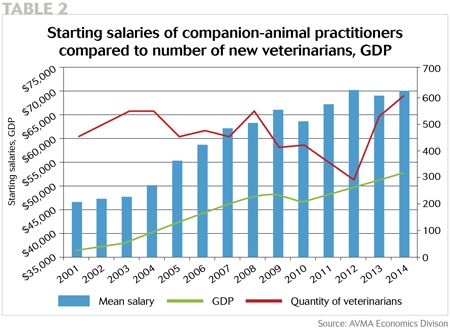How to predict veterinary compensation: part two
Examining why starting veterinary salaries vary from year to year.
All of us occasionally wonder, “What would have happened if … ?” Or “What's going to happen when … ?” Often the money we make (or could have made, or could still make) is a key component of this “what-if” thought process.
In my June AVMA Eye on Economics column in dvm360 we discussed the factors associated with differences in compensation levels among veterinarians in any given year. Knowing these factors can help answer income-related “what-if” questions such as, “What would my compensation have been if I'd moved to Nebraska, become board-certified and practiced mixed animal instead of equine veterinary medicine?”
Of course, we can calculate mean veterinary incomes-and the factors associated with earning more or less than the man-fairly easily by looking at the past. But what about the future? Can we predict what veterinarians will earn in coming years? Yes, to an extent. To determine future mean compensation, we need to forecast the future demand for veterinarians.
Econ in Boston
On Monday, July 12, economist Dr. Bridgette Bain will present two Eye on Economics Live sessions for AVMA Convention attendees. Topics are “How much do I pay my new associate?” and “How much can I expect to earn in five years?” Visit avmaconvention.org to register.
Demand is the relationship between price (wage) and quantity (number of veterinarians). In any year we have only one demand point, one mean wage and one quantity of veterinarians. To determine future demand, we select a particular time frame from which to gather a number of price (wage) and quantity points. To ensure that our mean starting salary is comparable year to year, we establish a constant cohort-a group with the same percentage of veterinarians by gender, location, age, hours worked and other important demographic factors shown to explain “within-year” variation in incomes. Once we calculate the mean salary of a constant cohort over the course of a number of years, we look at the relationship between price and quantity.
AVMA senior surveys conducted over the past 14 years reveal that the number of new veterinarians entering employment as companion-animal-exclusive practitioners after graduation ranged from 460 in 2001 to a low of 301 in 2012 and a high of 603 in 2014-see the red line in Table 1. The mean nominal starting salary also varied over the period, from a low of just over $45,000 in 2001 to a high of over $70,000 in 2010 and then returning to just below $70,000 in 2014.

However, the relationship between mean starting salary and the number of new veterinarians is unclear when we look at just those numbers. The theory of demand suggests that as the number of new veterinarians increases, their starting salaries should decline. And as the number of new veterinarians decreases, their starting salaries should increase. But Table 1 shows starting salaries increasing while the number of new companion-animal-exclusive practitioners remains relatively flat (2001 to 2008). And as the number of new veterinarians declines from 2008 to 2012, the mean starting salary also declines. Finally, as the number of new veterinarians increases in the 2012 to 2014 time period, starting salary also increases. Does this graph suggest that the theory of demand (an inverse price-quantity relationship) does not apply here?
No, because demand for companion-animal-exclusive practitioners and services depends on the demand made by pet owners-and their demand depends on their level of income. As pet owners' incomes rise, their demand for veterinary services rises. Consequently the demand for veterinarians rises, leading to an increased willingness of employers to offer higher starting salaries.
This becomes clear when we include per capita gross domestic product (GDP), a proxy for consumer income and other time-related variables, along with quantity of new veterinarians to explain changes in mean starting salaries. In Table 2, the mean starting salaries have been adjusted for the number of new veterinarians and per capita GDP. These two factors explain roughly 91 percent of the year-to-year variation in mean starting salaries.

Estimates indicate that between 2001 and 2014, each new veterinarian added to the companion-animal-exclusive workforce reduced the income of all new veterinarians by nearly $18. For every $1,000 added to per capita GDP, new veterinarian income increased by $1,610. Thus, adding 100 new veterinarians to the job market would offset a $1,000 increase in per capita GDP. In Table 2, consider the period from 2001 to 2008, where the number of new veterinarians becoming companion-animal-exclusive practitioners was roughly constant at around 500 (456 to 547) per year. Real-dollar starting salaries (see the blue bars) rose from nearly $47,000 in 2001 to just over $64,000 in 2008, which was in line with the growth of per capita GDP ($36,000 to $48,000).
When GDP rises, starting salaries increase. Likewise, when there is an increase in the number of new veterinarians entering full-time companion-animal-exclusive practice, the average starting salary declines. Knowing both the number of veterinary students in the pipeline and the forecast of growth in per capita GDP helps new veterinarians and veterinary employers gain insight into the future.

Predicting the number of new companion-animal-exclusive veterinary practitioners as a constant proportion of the estimated total number of new veterinarians and considering the Congressional Budget Office's forecast of GDP growth over the next 10 years, we can estimate mean starting salaries for veterinarians in this practice type between 2015 and 2024-see Table 3. This estimate does not include the possibility of new schools opening in the future or the occurrence of future economic recessions. But by using accurate numbers to examine the present, we can, in fact, look into the future of veterinary medicine.
Dr. Mike Dicks, director of the AVMA's Veterinary Economics Division, holds a doctorate in agricultural economics from the University of Missouri.